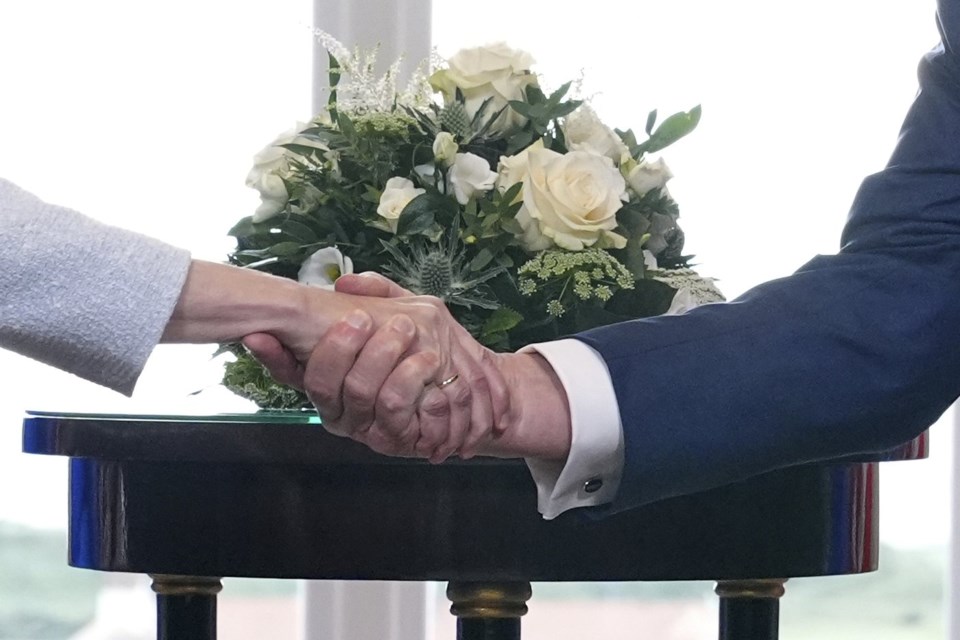WASHINGTON (AP) — For weeks, President Donald Trump was promising the world economy would change on Friday with his new tariffs in place. It was an ironclad deadline, administration officials assured the public.
But when Trump signed the order Thursday night imposing new tariffs, the start date of the punishing import taxes was pushed back seven days so the tariff schedule could be updated. The change in tariffs on 66 countries, the European Union, Taiwan and the Falkland Islands was potentially welcome news to countries that had not yet reached a deal with the U.S. It also injected a new dose of uncertainty for consumers and businesses still wondering what's going to happen and when.
Trump told NBC News in a Thursday night interview the tariffs process was going “very well, very smooth." But even as the Republican president insisted these new rates would stay in place, he added: “It doesn’t mean that somebody doesn’t come along in four weeks and say we can make some kind of a deal.”
Trump has promised that his tax hikes on the nearly $3 trillion in goods imported to the United States will usher in newfound wealth, launch a cavalcade of new factory jobs, reduce the budget deficits and, simply, get other countries to treat America with more respect.
The vast tariffs risk jeopardizing America's global standing as allies feel forced into unfriendly deals. As taxes on the raw materials used by U.S. factories and basic goods, the tariffs also threaten to create new inflationary pressures and hamper economic growth — concerns the Trump White House has dismissed.
Questions swirl around the tariffs despite Trump's eagerness
As the clock ticked toward Trump's self-imposed deadline, few things seemed to be settled other than the president's determination to levy the taxes he has talked about for decades. The very legality of the tariffs remains an open question as a U.S. appeals court on Thursday heard arguments on whether Trump had exceeded his authority by declaring an “emergency” under a 1977 law to charge the tariffs, allowing him to avoid congressional approval.
Trump was ebullient as much of the world awaited what he would do.
“Tariffs are making America GREAT & RICH Again,” he said Thursday morning on Truth Social.
Others saw a policy carelessly constructed by the U.S. president, one that could impose harms gradually over time that would erode America's power and prosperity.
“The only things we’ll know for sure on Friday morning are that growth-sapping U.S. import taxes will be historically high and complex, and that, because these deals are so vague and unfinished, policy uncertainty will remain very elevated,” said Scott Lincicome, a vice president of economics at the Cato Institute. “The rest is very much TBD.”
The new tariffs build off ones announced in the spring
Trump initially imposed the Friday deadline after his previous “Liberation Day” tariffs in April resulted in a stock market panic. His unusually high tariff rates unveiled then led to recession fears, prompting Trump to impose a 90-day negotiating period. When he was unable to create enough trade deals with other countries, he extended the timeline and sent out letters to world leaders that simply listed rates, prompting a slew of hasty agreements.
Swiss imports will now be taxed at a higher rate, 39%, than the 31% Trump threatened in April, while Liechtenstein saw its rate slashed from 37% to 15%. Countries not listed in the Thursday night order would be charged a baseline 10% tariff.
Trump negotiated trade frameworks over the past few weeks with the EU, Japan, South Korea, Indonesia and the Philippines — allowing the president to claim victories as other nations sought to limit his threat of charging even higher tariff rates. He said on Thursday there were agreements with other countries, but he declined to name them.
Thursday began with a palpable sense of tension
The EU was awaiting a written agreement on its 15% tariff deal. Switzerland and Norway were among the dozens of countries that did not know what their tariff rate would be, while Trump agreed after a Thursday morning phone call to keep Mexico’s tariffs at 25% for a 90-day negotiating period. The president separately on Thursday amended an order to raise Canada's fentanyl-related tariffs to 35%.
European leaders face blowback for seeming to cave to Trump, even as they insist that this is merely the start of talks and stress the importance of maintaining America's support of Ukraine's fight against Russia. Canadian Prime Minister Mark Carney has already indicated that his country can no longer rely on the U.S. as an ally, and Trump declined to talk to him on Thursday.
India, with its 25% tariff announced Wednesday by Trump, may no longer benefit as much from efforts to pivot manufacturing out of China. While the Trump administration has sought to challenge China's manufacturing dominance, it is separately in extended trade talks with that country, which faces a 30% tariff and is charging a 10% retaliatory rate on the U.S.
Major companies came into the week warning that tariffs would begin to squeeze them financially. Ford Motor Co. said it anticipated a net $2 billion hit to earnings this year from tariffs. French skincare company Yon-Ka is warning of job freezes, scaled-back investment and rising prices.
It’s unclear whether Trump’s new tariffs will survive a legal challenge
Federal judges sounded skeptical Thursday about Trump’s use of a 1977 law to declare the long-standing U.S. trade deficit a national emergency that justifies tariffs on almost every country on Earth.
“You’re asking for an unbounded authority,” Judge Todd Hughes of the U.S. Court of Appeals for the Federal Circuit told a Justice Department lawyer representing the administration.
The judges didn't immediately rule, and the case is expected to eventually reach the Supreme Court.
The Trump White House has pointed to the increase in federal revenues as a sign that the tariffs will reduce the budget deficit, with $127 billion in customs and duties collected so far this year — about $70 billion more than last year.
New tariffs threaten to raise inflation rates
There are not yet signs that tariffs will lead to more domestic manufacturing jobs, and the U.S. economy now has 14,000 fewer manufacturing jobs than it did in April.
On Thursday, one crucial measure of inflation, known as the Personal Consumption Expenditures index, showed that prices have climbed 2.6% over the 12 months that ended in June, a sign that inflation may be accelerating as the tariffs flow through the economy.
The prospect of higher inflation from the tariffs has caused the Federal Reserve to hold off on additional cuts to its benchmark rates, a point of frustration for Trump, who on Truth Social, called Fed Chair Jerome Powell a “TOTAL LOSER.”
But ahead of Trump's tariffs, Powell seemed to suggest that the tariffs had put the U.S. economy and much of the world into a state of unknowns.
“There are many uncertainties left to resolve,” Powell told reporters Wednesday. “So, yes, we are learning more and more. It doesn’t feel like we’re very close to the end of that process. And that’s not for us to judge, but it does — it feels like there’s much more to come.”
___
AP writer Paul Wiseman contributed to this report.
Josh Boak, The Associated Press




